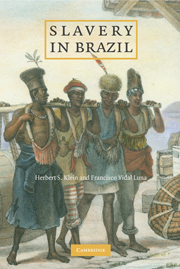Book contents
- Frontmatter
- Contents
- Preface
- I THE POLITICAL ECONOMY OF SLAVE LABOR
- 1 Origins of the African Slavery in Brazil
- 2 The Establishment of African Slavery in Brazil in the Sixteenth and Seventeenth Centuries
- 3 Slavery and the Economy in the Eighteenth Century
- 4 Slavery and the Economy in the Nineteenth Century
- 5 The Economics of Slavery
- II BRAZILIAN SLAVE SOCIETY
- III END OF SLAVERY
- Bibliography
- Index
5 - The Economics of Slavery
Published online by Cambridge University Press: 05 June 2012
- Frontmatter
- Contents
- Preface
- I THE POLITICAL ECONOMY OF SLAVE LABOR
- 1 Origins of the African Slavery in Brazil
- 2 The Establishment of African Slavery in Brazil in the Sixteenth and Seventeenth Centuries
- 3 Slavery and the Economy in the Eighteenth Century
- 4 Slavery and the Economy in the Nineteenth Century
- 5 The Economics of Slavery
- II BRAZILIAN SLAVE SOCIETY
- III END OF SLAVERY
- Bibliography
- Index
Summary
Slaves are the hands and feet of the senhor do engenho for without them Brazil could not make, conserve, or expand its resources, nor have a viable plantation system.
This famous affirmation of Padre Antonil made at the beginning of the eighteenth century could not be more true and need not be restricted to the senhores de engenho (or sugar mill planters). They were the basic labor for the majority, even of the free population, which depended on their services. In all the economic activities developed in Brazil until the last quarter of the nineteenth century, slaves were the essential labor force.
At the same time that the importance of slaves was recognized, there was also a biased vision created of that contemporaneous society in Brazil. This famous phrase, despite its obvious truth, perhaps lead to a distortion of the Brazilian society of the period. The idea of a slave mass and a planter elite to the exclusion of all other classes dominated Brazilian historiography until the first half of the twentieth century. Plantations, monoculture, and slave labor were considered the essence of Brazilian society. This society was segmented between just slave owners and slaves, with the latter seen as “things,” culturally backward, morally perverted, without any contribution to Brazilian culture. Fortunately, this vision of Brazilian society began to change beginning in the 1930s, particularly with the pioneer work of Gilberto Freyre, who gave life to the slaves and showed their important contribution to the formation of this culturally mixed society.
- Type
- Chapter
- Information
- Slavery in Brazil , pp. 115 - 148Publisher: Cambridge University PressPrint publication year: 2009



